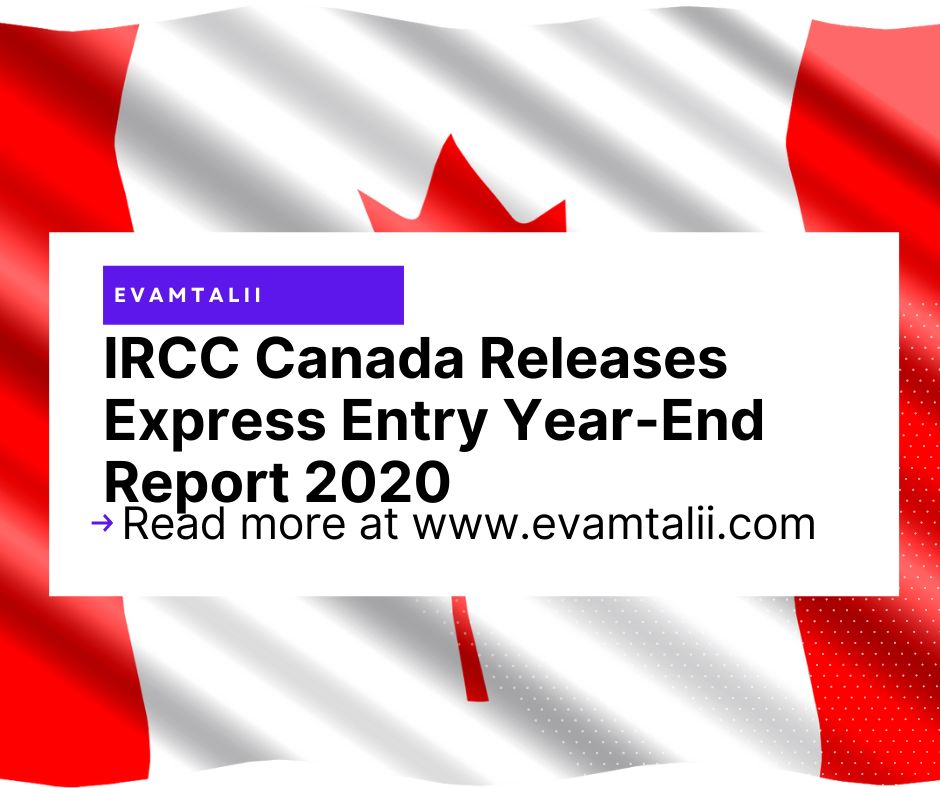IRCC Canada released the Express Entry Year-End Report 2020 on December 13, 2021.
The report shows
- who got to immigrate to Canada through (Canada’s main immigration pathway)
- impact of the pandemic on Express Entry immigration application system.
What's Covered in This Article
Report Highlights
The number of new permanent residents brought to Canada through Express Entry dropped to a three-year low.
The pandemic caused Express Entry admissions to fall below the level of ITAs issued.
Out of the ITAs issued in 2020, only 63,923 Express Entry applicants and their family members got permanent residence.
IRCC average processing time for applications was nine months
It failed to meet the standard of finalizing 80% of Express Entry applications within six months. The following table is based on data that was up-to-date in January, 2021.

Because of the pandemic, IRCC increased the validity period of an ITA from 60 to 90 days to allow applicants to have more time to process their applications.
Main source countries
- IRCC concentrated its invitations to apply at eligible Canadian Experience Class (CEC) and Provincial Nominee Program (PNP) candidates, as majority were already physically located in Canada and less likely to be impacted by international Covid mobility measures.
- More candidates invited from India than any foreign country.
- The top six countries of residence for invitations were the usual suspects from previous years: Canada, India, U.S., Nigeria, U.A.E., and Pakistan.

India was also the most common country of citizenship among those who received ITAs followed by People’s Republic of China, Nigeria, Pakistan, and the United Kingdom.

More Express Entry profiles were submitted by men than women as in previous years
Although fewer women were in the pool, their profiles were more likely to be eligible for at least one program, compared to men, which was consistent with the two years prior. IRCC reports 77% of women and 71% of men who submitted profiles were eligible for at least one program.
Both men and women applied most often under the CEC and least often under the Federal Skilled Trades Program (FSTP).
In each program, men were more likely than women to submit applications. The difference was more profound under the FSTP and less profound under the Federal Skilled Worker Program (FSWP).
Most common primary occupations upon invitation were IT and business and financial services
Most common primary occupations among candidates invited to apply for permanent residence were information technology, and business and financial services.
More food service supervisors and administrative assistants received ITAs most likely due to IRCC holding more CEC-specific rounds of invitations.

The most common arranged employment occupations were food service supervisors and computer programmers most likely as a result of the CEC draws.

CRS breakdown
There were many candidates in the pool who had a Comprehensive Ranking System (CRS) score in the 301-500 range.

Out of the 37 draws IRCC held in 2021, 21 were program-specific: 10 CEC draws, 10 PNP draws, and one FSTP draw. Minimum CRS scores ranged from 687 to 808 for PNP-specific rounds, and from 431 to 467 for CEC-specific rounds. The one FSTP draw had a cut-off score of 415.
In 2020, IRCC also increased the number of points awarded to French-speaking and bilingual candidates in the Express Entry pool; going up from 15 to 25 for French-speaking candidates, and from 30 to 50 for bilingual candidates.
Province of destination
More than 60% of Express Entry 2020 principal applicants gave Ontario as their province of destination.
Also, the number of principal applicants who intended to move to Saskatchewan, British Columbia, and New Brunswick increased in 2020, while those intending to permanently reside in Alberta and Nova Scotia decreased.

Majority of candidates who got permanent residence in 2020 were destined for Ontario, followed by British Columbia.





